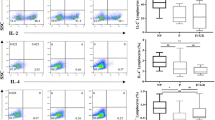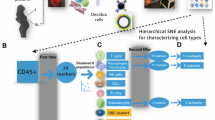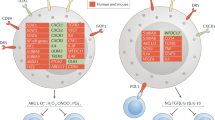Abstract
The maternal immune system is vital in maintaining immunotolerance to the semiallogeneic fetus for a successful pregnancy. Although studies have shown that myeloid-derived suppressor cells (MDSCs) play an important role in maintaining feto-maternal tolerance, little is known about the role of MDSCs in pregnancies with intrauterine growth retardation (IUGR). Here, we reported that the activation of polymorphonuclear myeloid-derived suppressor cells (PMN-MDSCs) during pregnancy was closely associated with fetal growth. In humans, class E scavenger receptor 1 (SR-E1), a distinct marker for human PMN-MDSCs, was used to investigate PMN-MDSC function during pregnancy. Continuous activation of SR-E1+ PMN-MDSCs was observed in all stages of pregnancy, accompanied by high cellular levels of ROS and arginase-1 activity, mediated through STAT6 signaling. However, SR-E1+ PMN-MDSCs in pregnancies with IUGR showed significantly lower suppressive activity, lower arginase-1 activity and ROS levels, and decreased STAT6 phosphorylation level, which were accompanied by an increase in inflammatory factors, compared with those in normal pregnancies. Moreover, the population of SR-E1+ PMN-MDSCs was negatively correlated with the adverse outcomes of newborns from pregnancies with IUGR. In mice, decreases in cell population, suppressive activity, target expression levels, and STAT6 phosphorylation levels were also observed in the pregnancies with IUGR compared with the normal pregnancies, which were rescued by the adoptive transfer of PMN-MDSCs from pregnant mice. Interestingly, the growth-promoting factors (GPFs) secreted by placental PMN-MDSCs in both humans and mice play a vital role in fetal development. These findings collectively support that PMN-MDSCs have another new role in pregnancy, which can improve adverse neonatal outcomes.
This is a preview of subscription content, access via your institution
Access options
Subscribe to this journal
Receive 12 digital issues and online access to articles
$119.00 per year
only $9.92 per issue
Buy this article
- Purchase on Springer Link
- Instant access to full article PDF
Prices may be subject to local taxes which are calculated during checkout






Similar content being viewed by others
References
Erlebacher, A. Immunology of the maternal-fetal interface. Annu. Rev. Immunol. 31, 387–411 (2013).
PrabhuDas, M. et al. Immune mechanisms at the maternal-fetal interface: perspectives and challenges. Nat. Immunol. 16, 328–334 (2015).
Romero, R., Dey, S. K. & Fisher, S. J. Preterm labor: one syndrome, many causes. Science 345, 760–765 (2014).
Arck, P. C. & Hecher, K. Fetomaternal immune cross-talk and its consequences for maternal and offspring’s health. Nat. Med. 19, 548–556 (2013).
Erlebacher, A. et al. Constraints in antigen presentation severely restrict T cell recognition of the allogeneic fetus. J. Clin. Investig. 117, 1399–1411 (2007).
Verdijk, R. M. et al. Pregnancy induces minor histocompatibility antigen-specific cytotoxic T cells: implications for stem cell transplantation and immunotherapy. Blood 103, 1961–1964 (2004).
Fu, B. Q. et al. Natural killer cells promote fetal development through the secretion of growth-promoting factors. Immunity 47, 1100–1113 (2017).
Msallam, R. et al. Fetal mast cells mediate postnatal allergic responses dependent on maternal IgE. Science 370, 941–950 (2020).
Wang, W., Sung, N. Y., Gilman-Sachs, A. & Kwak-Kim, J. T helper (Th) cell profiles in pregnancy and recurrent pregnancy losses: Th1/Th2/Th9/Th17/Th22/Tfh cells. Front. Immunol. 11, 2025 (2020).
Huhn, O. et al. Distinctive phenotypes and functions of innate lymphoid cells in human placenta during early pregnancy. Nat. Commun. 11, 381 (2020).
Wang, L. L. et al. The dynamic profile and potential function of B-cell subsets during pregnancy. Cell. Mol. Immunol. 18, 1082–1084 (2020).
Cai, D. L., Tang, Y. H. & Yao, X. Y. Changes of γδT cell subtypes during pregnancy and their influences in spontaneous abortion. J. Reprod. Immunol. 131, 57–62 (2019).
Noman, M. Z. et al. PD-L1 is a novel direct target of HIF-1α, and its blockade under hypoxia enhanced MDSC-mediated T cell activation. J. Exp. Med. 211, 781–790 (2014).
Chabtini, L. et al. TIM-3 regulates innate immune cells to induce fetomaternal tolerance. J. Immunol. 190, 88–96 (2013).
D’Addio, F. et al. The link between the PDL1 costimulatory pathway and Th17 in fetomaternal tolerance. J. Immunol. 187, 4530–4541 (2011).
Hosseini, A. et al. Regulatory T and T helper 17 cells: their roles in preeclampsia. J. Cell. Physiol. 233, 6561–6573 (2018).
Gomez-Lopez, N. et al. Regulatory T cells play a role in a subset of idiopathic preterm labor/birth and adverse neonatal outcomes. Cell. Rep. 32, 107874 (2020).
Mandruzzato, G. et al. Intrauterine restriction (IUGR). J. Perinat. Med. 36, 277–281 (2008).
Pilliod, R. A. et al. The risk of intrauterine fetal death in the small-for-gestational-age fetus. Am. J. Obstet. Gynecol. 207, e1–e6.318 (2012).
Sharma, D., Shastri, S., Farahbakhsh, N. & Sharma, P. Intrauterine growth restriction—part 1. J. Matern. Fetal Neonatal Med. 29, 3977–3987 (2016).
Veerbeek, J. H. et al. Placental pathology in early intrauterine growth restriction associated with maternal hypertension. Placenta 35, 696–701 (2014).
John, R. M. Imprinted genes and the regulation of placental endocrine function: pregnancy and beyond. Placenta 56, 86–90 (2017).
Bronte, V. et al. Recommendations for myeloid-derived suppressor cell nomenclature and characterization standards. Nat. Commun. 7, 12150 (2016).
Gabrilovich, D. I. Myeloid-derived suppressor cells. Cancer Immunol. Res. 5, 3–8 (2017).
Gabrilovich, D. I., Ostrand-Rosenberg, S. & Bronte, V. Coordinated regulation of myeloid cells by tumours. Nat. Rev. Immunol. 12, 253–268 (2012).
Youn, J. I., Collazo, M., Shalova, I. N., Biswas, S. K. & Gabrilovich, D. I. Characterization of the nature of granulocytic myeloid-derived suppressor cells in tumor-bearing mice. J. Leukoc. Biol. 91, 167–181 (2012).
He, Y. M. et al. Transitory presence of myeloid-derived suppressor cells in neonates is critical for control of inflammation. Nat. Med. 24, 224–231 (2018).
Pan, T. et al. 17β-Oestradiol enhances the expansion and activation of myeloid-derived suppressor cells via signal transducer and activator of transcription (STAT)-3 signalling in human pregnancy. Clin. Exp. Immunol. 185, 86–97 (2016).
Nair, R. R., Sinha, P., Khanna, A. & Singh, K. Reduced myeloid-derived suppressor cells in the blood and endometrium is associated with early miscarriage. Am. J. Reprod. Immunol. 73, 479–486 (2015).
Pan, T. et al. Myeloid-derived suppressor cells are essential for maintaining feto-maternal immunotolerance via STAT3 signaling in mice. J. Leukoc. Biol. 100, 499–511 (2016).
Condamine, T. et al. Lectin-type oxidized LDL receptor-1 distinguishes population of human polymorphonuclear myeloid-derived suppressor cells in cancer patients. Sci. Immunol. 1, aaf8943 (2016).
PrabhuDas, M. R. et al. A consensus definitive classification of scavenger receptors and their roles in health and disease. J. Immunol. 198, 3775–3789 (2017).
Köstlin, N. et al. Granulocytic myeloid derived suppressor cells expand in human pregnancy and modulate T-cell responses. Eur. J. Immunol. 44, 2582–2591 (2014).
Tavukcuoglu, E. et al. Human splenic polymorphonuclear myeloid-derived suppressor cells (PMN-MDSC) are strategically located immune regulatory cells in cancer. Eur. J. Immunol. 50, 2067–2074 (2020).
Veglia, F., Perego, M. & Gabrilovich, D. I. Myeloid-derived suppressor cells coming of age. Nat. Immunol. 19, 108–119 (2018).
Nan, J. et al. Endoplasmic reticulum stress induced LOX-1(+) CD15(+) polymorphonuclear myeloid-derived suppressor cells in hepatocellular carcinoma. Immunology 154, 144–155 (2018).
Abu-Raya, B., Michalski, C., Sadarangani, M. & Lavoie, P. M. Maternal immunological adaptation during normal pregnancy. Front. Immunol. 11, 575197 (2020).
Rackaityte, E. & Halkias, J. Mechanisms of fetal T cell tolerance and immune regulation. Front. Immunol. 11, 588 (2020).
Miller, D. et al. Maternal and fetal T cells in term pregnancy and preterm labor. Cell. Mol. Immunol. 17, 693–704 (2020).
Bezemer, R. E. et al. Altered levels of placental immune cell subsets in fetal growth restriction, stillbirth, and placental pathology. Front. Immunol. 11, 1898 (2020).
Li, Y. H. et al. The Galectin-9/Tim-3 pathway is involved in the regulation of NK cell function at the maternal-fetal interface in early pregnancy. Cell. Mol. Immunol. 13, 73–81 (2016).
Dutta, S., Senguptaet, P. & Haque, N. Reproductive immunomodulatory functions of B cells in pregnancy. Int. Rev. Immunol. 39, 53–66 (2020).
Wang, S. C. et al. Programmed cell death-1 (PD-1) and T-cell immunoglobulin mucin-3 (Tim-3) regulate CD4+ T cells to induce Type 2 helper T cell (Th2) bias at the maternal-fetal interface. Hum. Reprod. 31, 700–711 (2016).
Zhang, Y. H. et al. The altered PD-1/PD-L1 pathway delivers the ‘one-two punch’ effects to promote the Treg/Th17 imbalance in pre-eclampsia. Cell. Mol. Immunol. 15, 710–723 (2018).
Li, C. C. et al. Decidua-derived granulocyte macrophage colony-stimulating factor induces polymorphonuclear myeloid-derived suppressor cells from circulating CD15+ neutrophils. Hum. Reprod. 35, 2677–2691 (2020).
Miko, E. et al. Immune checkpoint molecules in reproductive immunology. Front. Immunol. 10, 846 (2019).
Ghaebi, M. et al. Immune regulatory network in successful pregnancy and reproductive failures. Biomed. Pharmacother. 88, 61–73 (2017).
Köstlin, N. et al. Granulocytic myeloid-derived suppressor cells accumulate in human placenta and polarize toward a Th2 phenotype. J. Immunol. 196, 1132–1145 (2016).
Si, Y. et al. Multidimensional imaging provides evidence for down-regulation of T cell effector function by MDSC in human cancer tissue. Sci. Immunol. 4, eaaw9159 (2019).
Zhang, Y. et al. Human trophoblast cells induced MDSCs from peripheral blood CD14(+) myelomonocytic cells via elevated levels of CCL2. Cell. Mol. Immunol. 13, 615–627 (2016).
Ren, J. B. et al. Myeloid-derived suppressor cells depletion may cause pregnancy loss via upregulating the cytotoxicity of decidual natural killer cells. Am. J. Reprod. Immunol. 81, e13099 (2019).
Köstlin, N. et al. HLA-G promotes myeloid-derived suppressor cell accumulation and suppressive activity during human pregnancy through engagement of the receptor ILT4. Eur. J. Immunol. 47, 374–384 (2017).
Lu, H. et al. Rapamycin prevents spontaneous abortion by triggering decidual stromal cell autophagy-mediated NK cell residence. Autophagy https://doi.org/10.1080/15548627.2020.1833515 (2020).
Wang, Y. N. et al. Inhibition of pregnancy-associated granulocytic myeloid-derived suppressor cell expansion and arginase-1 production in preeclampsia. J. Reprod. Immunol. 127, 48–54 (2018).
Fu, B. Q., Tian, Z. G. & Wei, H. M. TH17 cells in human recurrent pregnancy loss and pre-eclampsia. Cell. Mol. Immunol. 11, 564–570 (2014).
Wang, S. C. et al. PD-1 and Tim-3 pathways are associated with regulatory CD8+ T-cell function in decidua and maintenance of normal pregnancy. Cell. Death. Dis. 6, e1738 (2015).
Ding, H. L. et al. Upregulation of CD81 in trophoblasts induces an imbalance of Treg/Th17 cells by promoting IL-6 expression in preeclampsia. Cell. Mol. Immunol. 16, 302–312 (2019).
Sharma, D., Farahbakhsh, N., Shastri, S. & Sharma, P. Intrauterine growth restriction—part 2. J. Matern. Fetal Neonatal Med. 29, 4037–4048 (2016).
Saleem, T. et al. Intrauterine growth retardation–small events, big consequences. Ital. J. Pediatr. 37, 41 (2011).
Sacchi, C. et al. Association of intrauterine growth restriction and small for gestational age status with childhood cognitive outcomes: a systematic review and meta-analysis. Jama. Pediatr. 174, 772–781 (2020).
Lager, S. et al. Abnormal placental CD8(+) T-cell infiltration is a feature of fetal growth restriction and pre-eclampsia. J. Physiol. 598, 5555–5571 (2020).
Lin, F. et al. The maternal-fetal interface in small-for-gestational-age pregnancies is associated with a reduced quantity of human placental NK cells with weaker functional ability. Front. Cell. Dev. Biol. 8, 633 (2020).
Wang, H. K. et al. The transcription factor Foxp1 is a critical negative regulator of the differentiation of follicular helper T cells. Nat. Immunol. 15, 667–675 (2014).
Sidwell, T. et al. Attenuation of TCR-induced transcription by Bach2 controls regulatory T cell differentiation and homeostasis. Nat. Commun. 11, 252 (2020).
Sarhan, D. et al. Adaptive NK cells with low TIGIT expression are inherently resistant to myeloid-derived suppressor cells. Cancer Res. 76, 5696–5706 (2016).
Steggerda, S. M. et al. Inhibition of arginase by CB-1158 blocks myeloid cell-mediated immune suppression in the tumor microenvironment. J. Immunother. Cancer 5, 101 (2017).
Heine, A. et al. The JAK-inhibitor ruxolitinib impairs dendritic cell function in vitro and in vivo. Blood 122, 1192–1202 (2013).
Ugolini, A. et al. Polymorphonuclear myeloid-derived suppressor cells limit antigen cross-presentation by dendritic cells in cancer. Jci. Insight 5, e138581 (2020).
Zhang, Z. et al. Intrauterine growth restriction programs intergenerational transmission of pulmonary arterial hypertension and endothelial dysfunction via sperm epigenetic modifications. Hypertension 74, 1160–1171 (2019).
Acknowledgements
This work was supported by grants from the following institutions: the High-level Talent Start-up Funding of Southern Medical University, the National Natural Science Foundation of China (grant numbers: 31700061, 81971420 and 81991511), the Guangdong Special Support Program for Youth Science and Technology Innovation Talents (grant number: 2019TQ05Y585), the National Natural Science Foundation of Guangdong (grant number: 2019A1515011435), and the Science and Technology Program of Guangzhou (grant number: 201904010073).
Author information
Authors and Affiliations
Contributions
Y.H., L.W., and G.X. designed the study. M.S., Z.C., M.C., J.L., J.L., Z.X., X.Z., S.L., X.L., S.Z., S.F., and Y.L. performed the experiments in this study. Y.H., L.W., and G.X. wrote the paper. All authors contributed to the discussion of the study and revision of the paper.
Corresponding authors
Ethics declarations
Competing interests
The authors declare no competing interests.
Supplementary information
Rights and permissions
About this article
Cite this article
Shi, M., Chen, Z., Chen, M. et al. Continuous activation of polymorphonuclear myeloid-derived suppressor cells during pregnancy is critical for fetal development. Cell Mol Immunol 18, 1692–1707 (2021). https://doi.org/10.1038/s41423-021-00704-w
Received:
Accepted:
Published:
Issue Date:
DOI: https://doi.org/10.1038/s41423-021-00704-w



